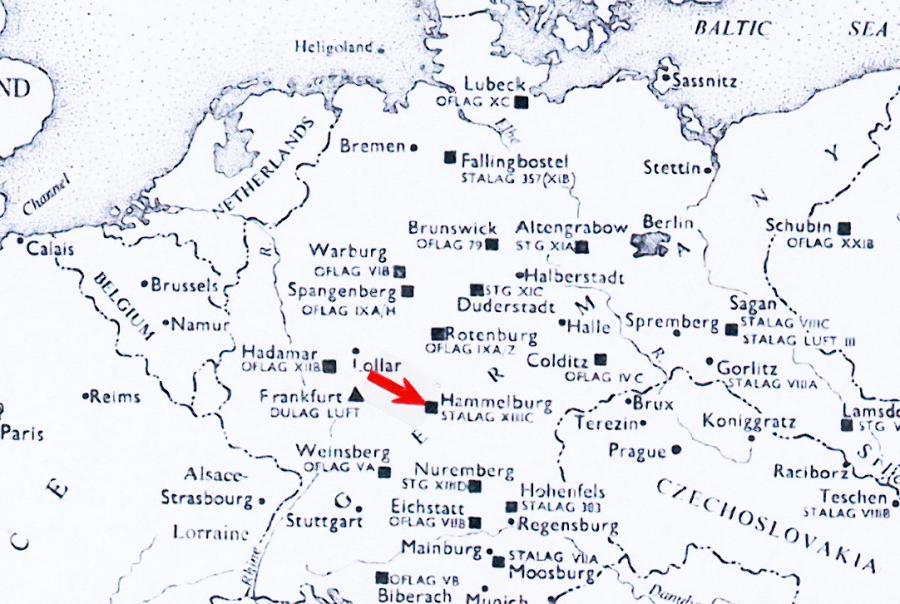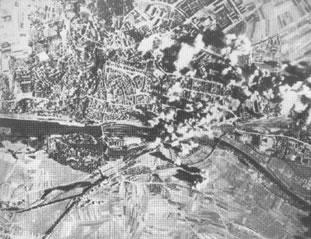Undercover POW
As a curator cataloguing objects in the Memorial’s collections, I have had the chance to discover and research many interesting war time stories and experiences of Australian service personnel. One such interesting story that I found was of Sergeant Rolstyn Nicholas Tonkin. As a prisoner of the Germans during the Second World War, Tonkin risked severe punishment to provide intelligence for the Allied war effort.
1940. Group portrait of members of 2/3rd light anti-aircraft regiment (LAA)
Tonkin was born in Bendigo, Victoria and was twenty seven when he enlisted in the second AIF on the 25 July 1940. He joined the 7th Battery 2/3rd Light Anti Aircraft (LAA) Regiment and left Australia aboard HMT Mauretania on 29 December 1940. Tonkin arrived in Palestine on 31 January 1941 and the following day the unit moved by train and bus to Khassa Camp north of Gaza.
On 6 April the Germans launched Operation Marita, the invasion of Greece and the Allied situation there quickly become serious. Tonkin’s unit was due to join Lustre Force in Greece but because of the rapid German advance, 7th Battery was ordered to Crete to take-over defence of the islands air bases.
Officers of all the units which arrived in Crete from Greece await the arrival of Major General Sir Bernard C Freyberg, VC, KCB, KBE, CMG, DSO, April 1941, Suda Bay, Crete." src="https://www.awm.gov.au/screen_img/0698
Arriving at Sunda Bay on 24 April 1941, Tonkin was confronted with the large number of troops that had been evacuated to Crete following the Allied withdrawal from Greece. Over the next few days thousands more would arrive. Tonkin assisted by distributing food and water, and working on the wharf under constant bombing from the Luftwaffe.
Thessaly, Greece, 1941-05. Larissa Aerodrome. German parachute troops embarking on a troop carrying "Junkers" aircraft for Crete.
Maleme, Crete. 1941-05-18. Membersof 'A' Troop, 2/7th Battery, 2/3rd Light Anti-Aircraft Regiment, with a 40mm Bofors gun on the north side of Maleme Airfield.
In early May 1941 Tonkin’s unit, along with a rifle company of the 22nd New Zealand Battalion (NZ Btn), was tasked with defending the airfield at Maleme using Bofors anti-aircraft guns. They had no practical or operational experience with the Bofors predictor equipment (target computer) nor had they ever fired the Bofors anti-aircraft gun until practically on the eve of battle. [1] As the Germans gave them no respite in aerial attacks the gunners learnt on the job. With the Australian’s black sense humour these attacks became known as the ‘daily strafe’.[2]
Crete, 1941-05-20. German paratroops, part of the German airborne invasion of Crete, parachuting onto the village of Suda.
On the morning of 20 May the gunners noticed more enemy planes than usual. In a short time around seventy five German gliders had landed along with parachute troops around the airfield. By the middle of the afternoon they were overpowered by the Germans and small groups of gunners were trying to make their escape back to the main lines of the 22nd NZ Btn. Tonkin was with A Troop Headquarters and was cut off and surrounded by Germans. The order was given to withdraw up a neighbouring valley through the Germans to meet up with allied lines. In the attempt to breakout Tonkin was captured by the Germans. He was put to work by his captors, unloading planes carrying ammunition and supplies and loading German wounded back on the flights out. He was also forced to fill in craters and move wrecked planes off the runway, during which he did as much as possible to ‘disrupt the movement of [German] planes.’[3]
Crete, May 1941. The Battle of Crete. German parachute troops being landed from troop-carrying planes in Crete. View over Heraklion and Maleme Aerodrome.
Tonkin was moved to Stalag XIII C prisoner of war camp near the town of Hammelburg on 18 August 1941. The camp held over 30 000 prisoners including approximately 1000 Australians. Tonkin worked in the Kartei (an office that maintained the index card system that tracked the camps prisoners) as a clerk looking after the records of the British Commonwealth troops.

During his time in Stalag XIII C Tonkin met Padre Captain John King who had been captured at Dunkirk. King was tasked with gathering intelligence around Hammelburg. Padres were considered non-combatants or protected personnel and were allowed to travel around Germany unescorted during their time as prisoners to minister to Australian POWs. King recruited Tonkin alongside Acting Bombardier Law Rolling who worked in the camp post office, a useful position which allowed him to intercept letters and parcels.
Group portrait of Australian Prisoners of War at Stalag XIIIc in Hammelburg am Main, Germany. Tonkin is standing far left and Rolling is standing third from right
Tonkin spent over three years in Stalag XIII C passing information back to military intelligence in England that could be used in the bombing campaign against Germany. Messages were sent via letters written in a special code and reported on German military and industrial sites around Hammelburg. This included the ball bearing factories at Schweinfurt which were targeted because bearings were essential in the manufacture of tanks, planes and vehicles. The destruction of the factories was seen as vital in the endeavour to hamper German industry and its war effort. They also intercepted bogus parcels sent by British military intelligence which contained escape equipment for the camp.
Prisoners at the German prisoner of war camp Stalag XIIIc. Tonkin is seated second row from the front, fourth from the right. Rolling is standing third row down fifth from the left.
By early 1944 Tonkin was transferred to work at the POW hospital at Ebelsbach east of Schweinfurt as a liaison officer, smoothing relations between the Germans and Commonwealth troops. Gaining the trust of the German authorities Tonkin was allowed to travel alone within 5 kilometres of the hospital which helped in his intelligence gathering. One of his duties at the hospital was to collect distilled water from a Tiger tank depot in Schweinfurt. Tonkin reported information about the depot to London and it was targeted in a subsequent raid.

Trips into big cities were dangerous because of Allied bombing. During trips into Schweinfurt in April and July 1944, Tonkin was caught in bombing raids. Both times he and his escort were forced into a shelter where German civilians noticed Tonkin’s British battle dress and became agitated. Tonkin feared he would be attacked. Deciding discretion was the better part of valour, he waited outside during the raid while his German escort stayed in the shelter.
By September 1944, the Allies had gained air superiority and intelligence could be gathered by aircraft, so the nature of Tonkin’s work changed. Propaganda messages such as ‘surrender’ were to be painted on walls and there were instructions on how to keep POWs off the roads so not to obstruct the Allied armies.
In late September after an altercation with a Gestapo captain at Ebelsbach railway station, Tonkin was cautioned by the hospital commandant and sent back to Stalag XIII C. When the prison camp was liberated by the 47th United States Tank Battalion on 6 April 1945 the guards had already left. Tonkin and several others departed two days later and by hitch hiking and flying with the US and Canadian air forces they arrived on 11 April in London. Tonkin travelled back to Australia arriving in Sydney in June and was discharged the following month. In February 1946 Tonkin was Mentioned in Despatches in recognition of gallant and distinguished services in the field.
Tonkin was one of many Allied POWs who worked in small groups to gathered intelligence against the Germans. If caught, they risked severe punishment or even death but were still determined to do their bit against Nazi Germany.
[1] C. J. E Rae, A.L Harris, and R. K Bryant, On target : the story of the 2/3rd Australian Light Anti-Aircraft Regiment from formation on 18th July, 1940 until disbandment on 14th July, 1943, and the subsequent service of 7th Battery, 8th Battery, and 9th Battery, until the end of World War II. 2/3rd Australian Light Anti-Aircraft Regiment Association, (Victoria, 1987) p41.
[2]Gavin Long, Australia in the War of 1939-45 Army; Greece, Crete and Syria. (Canberra, Australian War Memorial, 1953) p221.
[3] C. J. E Rae, A.L Harris, and R. K Bryant, On target : the story of the 2/3rd Australian Light Anti-Aircraft Regiment, p 79
Further Reading
Greville, Howard. Prison Camp Spies: Intelligence Gathering Behind the Wire. (Loftus, NSW, Australian Military History Publications, 1998).
Long , Gavin. Australia in the War of 1939-45 Army; Greece, Crete and Syria. (Canberra, Australian War Memorial, 1953).
Rae, C. J. E, Harris, A. L. and Bryant, R. K. On target : the story of the 2/3rd Australian Light Anti-Aircraft Regiment from formation on 18th July, 1940 until disbandment on 14th July, 1943, and the subsequent service of 7th Battery, 8th Battery, and 9th Battery, until the end of World War II. 2/3rd Australian Light Anti-Aircraft Regiment Association, (Victoria, 1987).
Tonkin, Rolstyn Nicholas. AWM PR03241.
Tonkin, Rolstyn Nicholas. NAA B883, VX37081.








